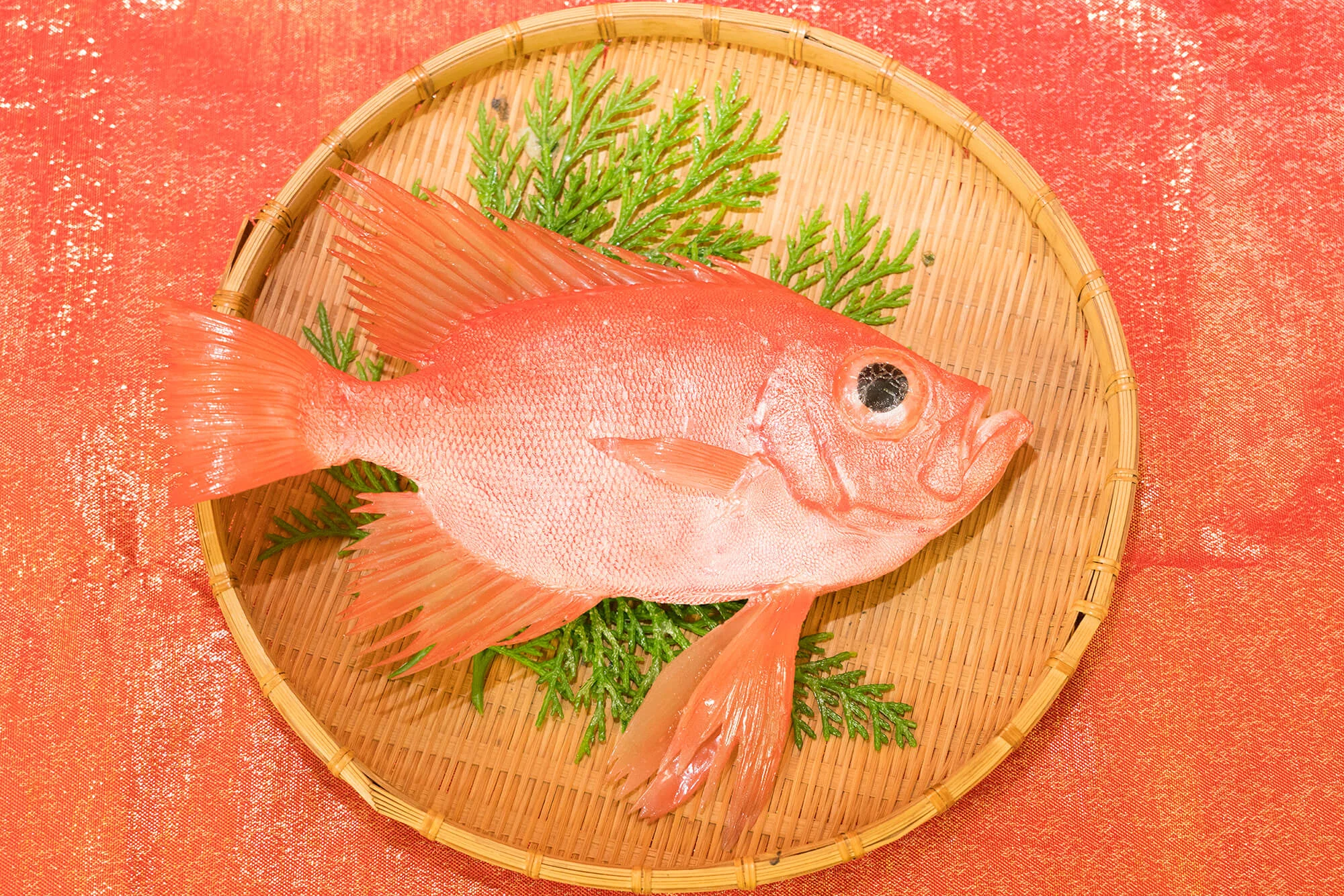
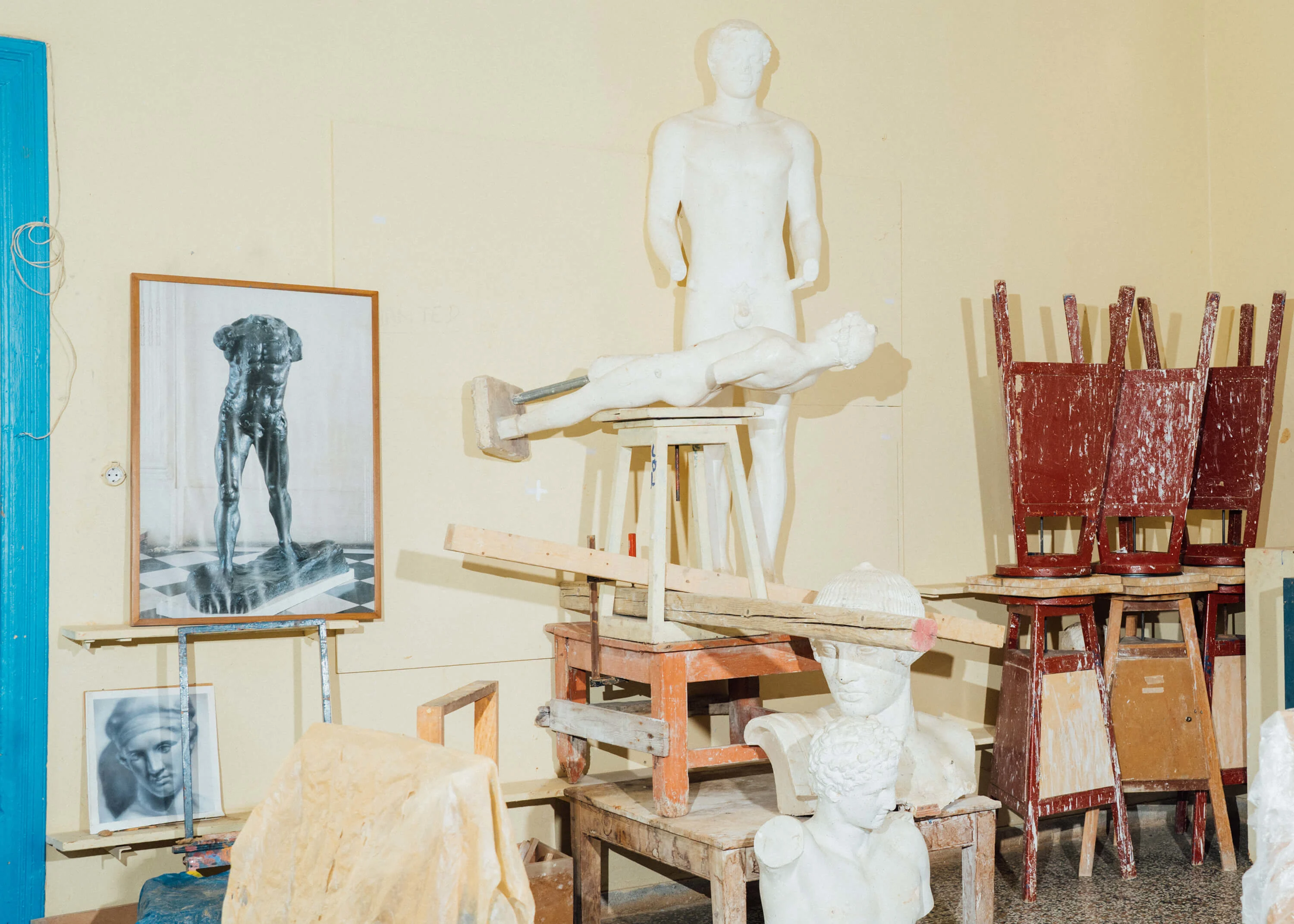
In the sun-dappled village of Pyrgos, on the Greek island of Tinos, huge clumps of marble spout out of the ground like daisies. In days gone by, the demand for this glittering rock to be turned into functional, immortal objects was high. These days, less so. Writer and marble carver Sarah Souli and photographer Marco Arguello travelled to these near-mythical lands to meet the dusty, happy craftsmen keeping the ancient tradition of marble carving alive.
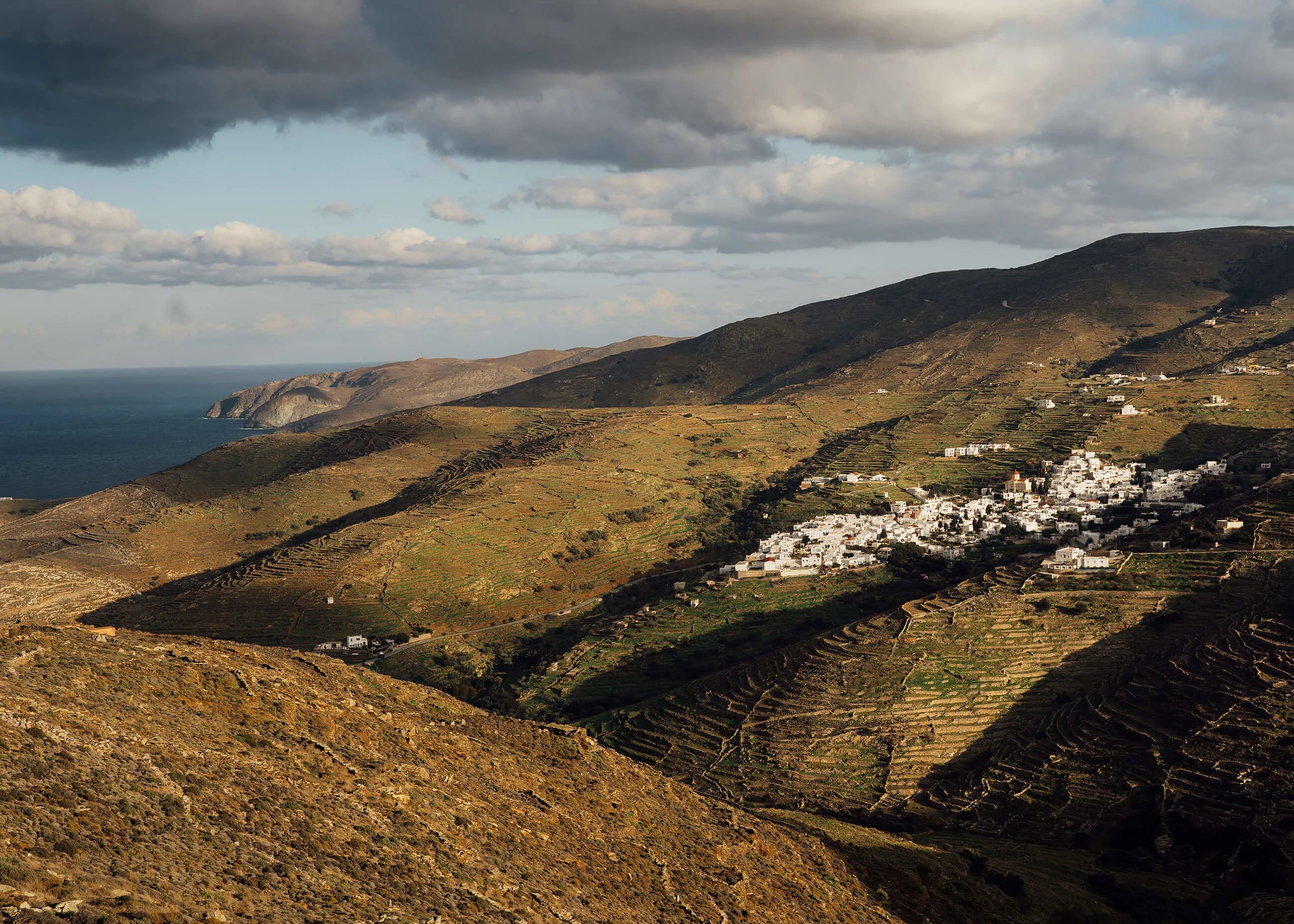
It’s difficult to write about Greece and not begin with a mention of the extraordinary light: a hazy dapple that is unique even by sun-drenched Mediterranean standards. It’s particularly prevalent on the Cycladic island of Tinos, in the marble village of Pyrgos, where the endless expanse of white crystalline rock reflects the golden sun, making the entire village glitter. “The light in Greece is so special,” confirms Petros Marmarinos, a local marble sculptor whose name, in baptismal serendipity, roughly translates to Rocky Marbles. “Light is an integral part of both the sculpting process and the finished product.”
Northern light is the best, he notes, which is the direction his main studio faces; his tools and artworks bathed in a glowing light that highlights the shadows and depths of carved surfaces. His backyard, the scent of fig and oranges heavy in the air, moonlights as a storage space for half-completed marble pieces. Geckos dart across half finished busts, and sleepy cats using jump over leaning slabs of marble as makeshift beds.
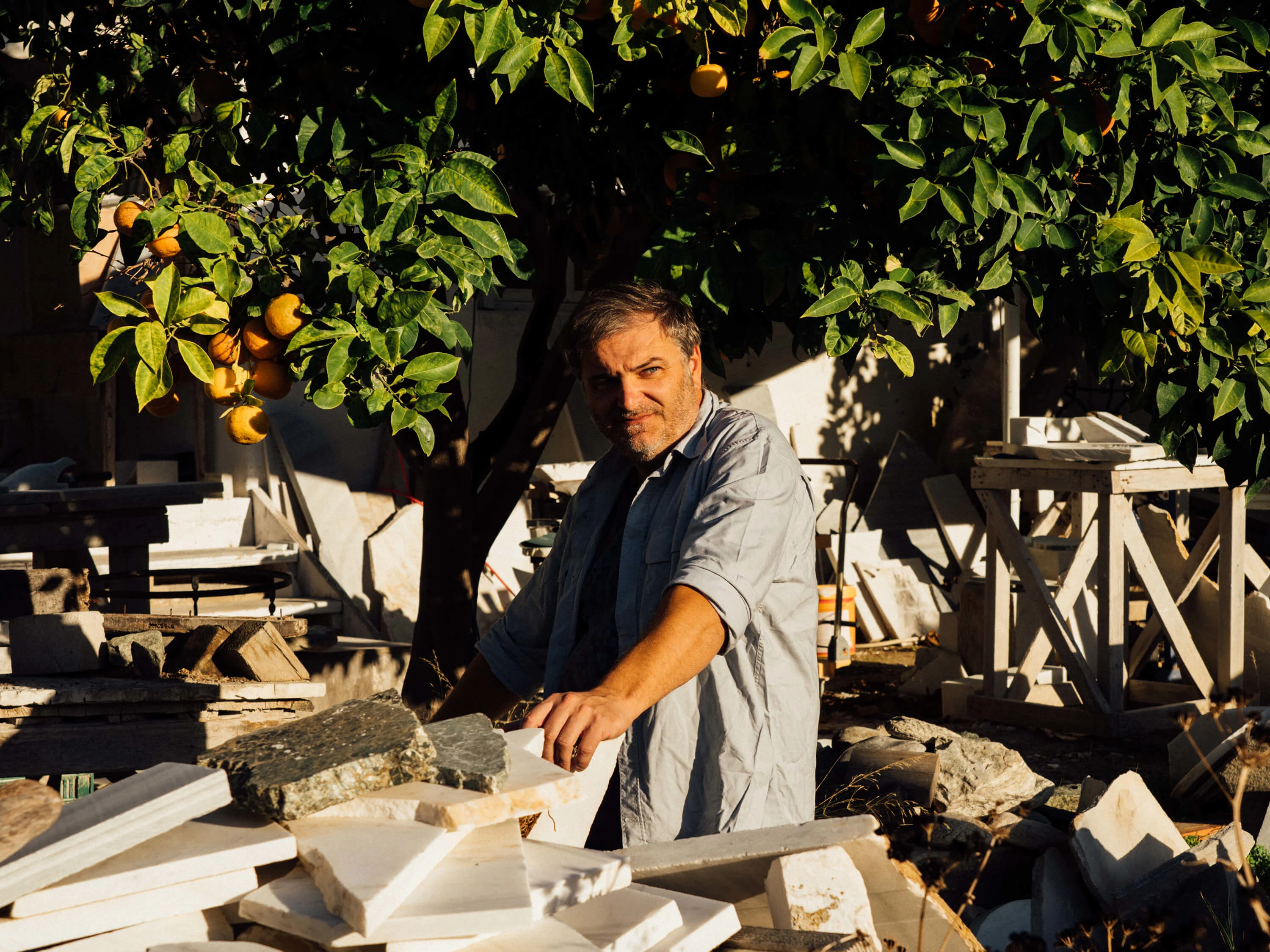
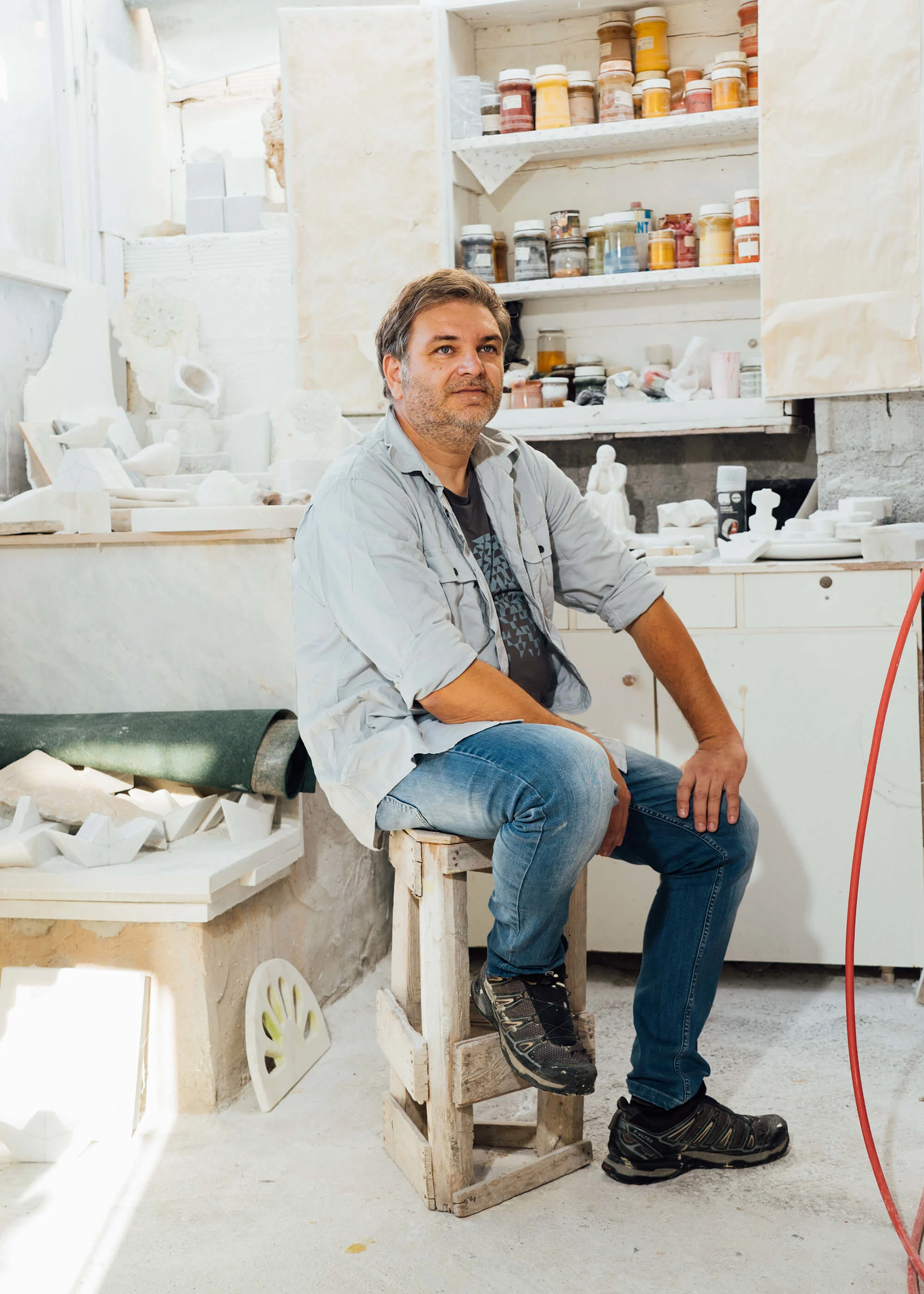
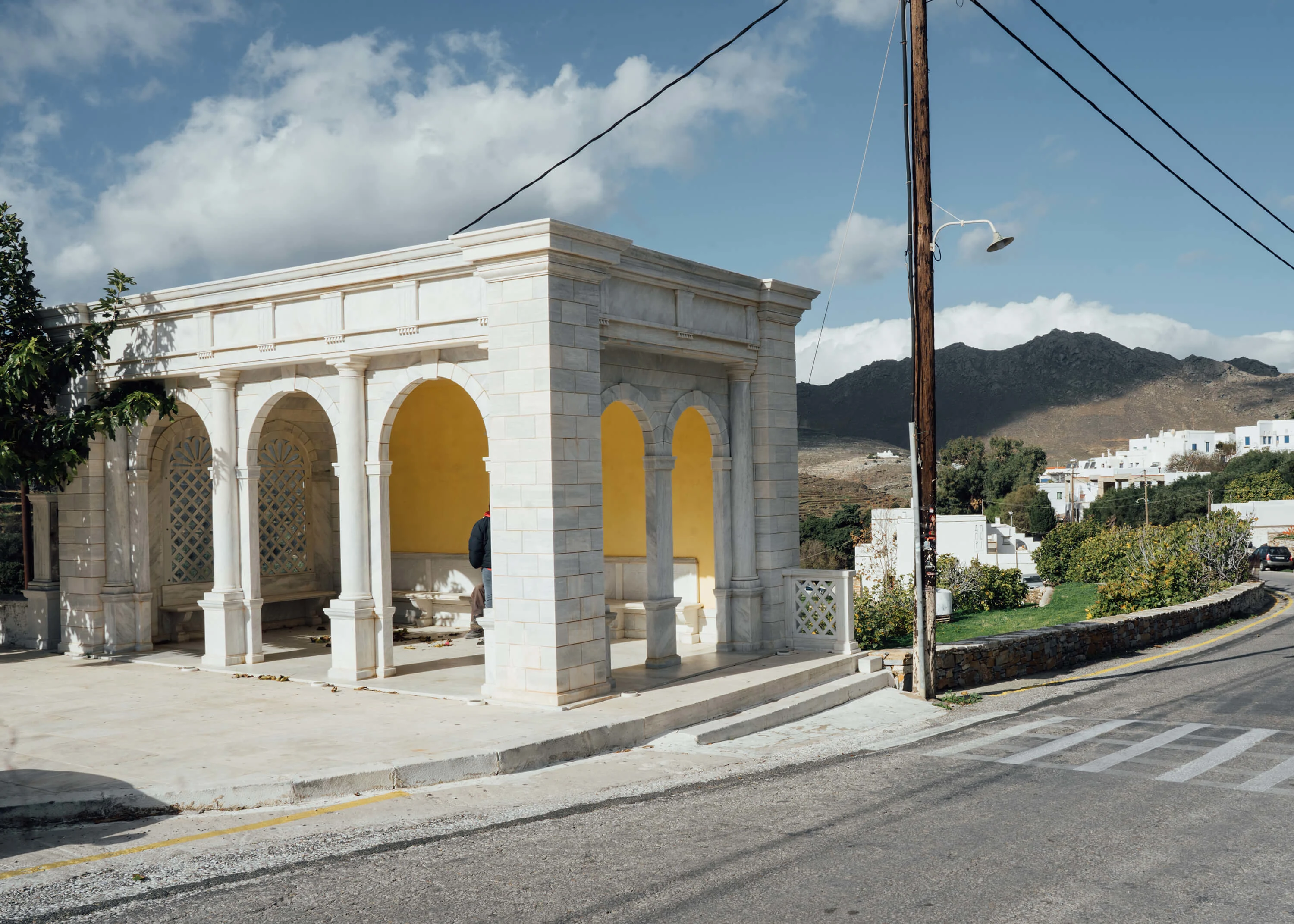
Marmarinos’ backyard is a fairly common sight in Pyrgos. Nearly everything in the village is made of marble: the sidewalks and the fountains, of course, but also the street signs, gutters, bus stops, and motifs decorating the facades of houses, too. Above the door of one house I see a marble sculpture of a weary-eyed, long haired woman cupping her right breast. As I contemplate who she is, or what series of events led to her clutching her bosom, I think about how I ended up here, on an island in the middle of the Aegean sea, surrounded by shimmering rocks.
I started carving marble because everyone else was making ceramics; an obnoxious aspect of my personality that quickly blossomed into an obsession. I found an airy workshop in Athens, a short walk from my apartment, and spent hours carving lines till my right bicep grew bigger than my left and my hands turned numb. My instructor, a second-generation marble sculptor patiently answered my questions: How do you feel when you carve? When will I be good at this? Where do you buy your tools? Why are there so few of you left? until, slightly exasperated, he said; “Go to Tinos!”
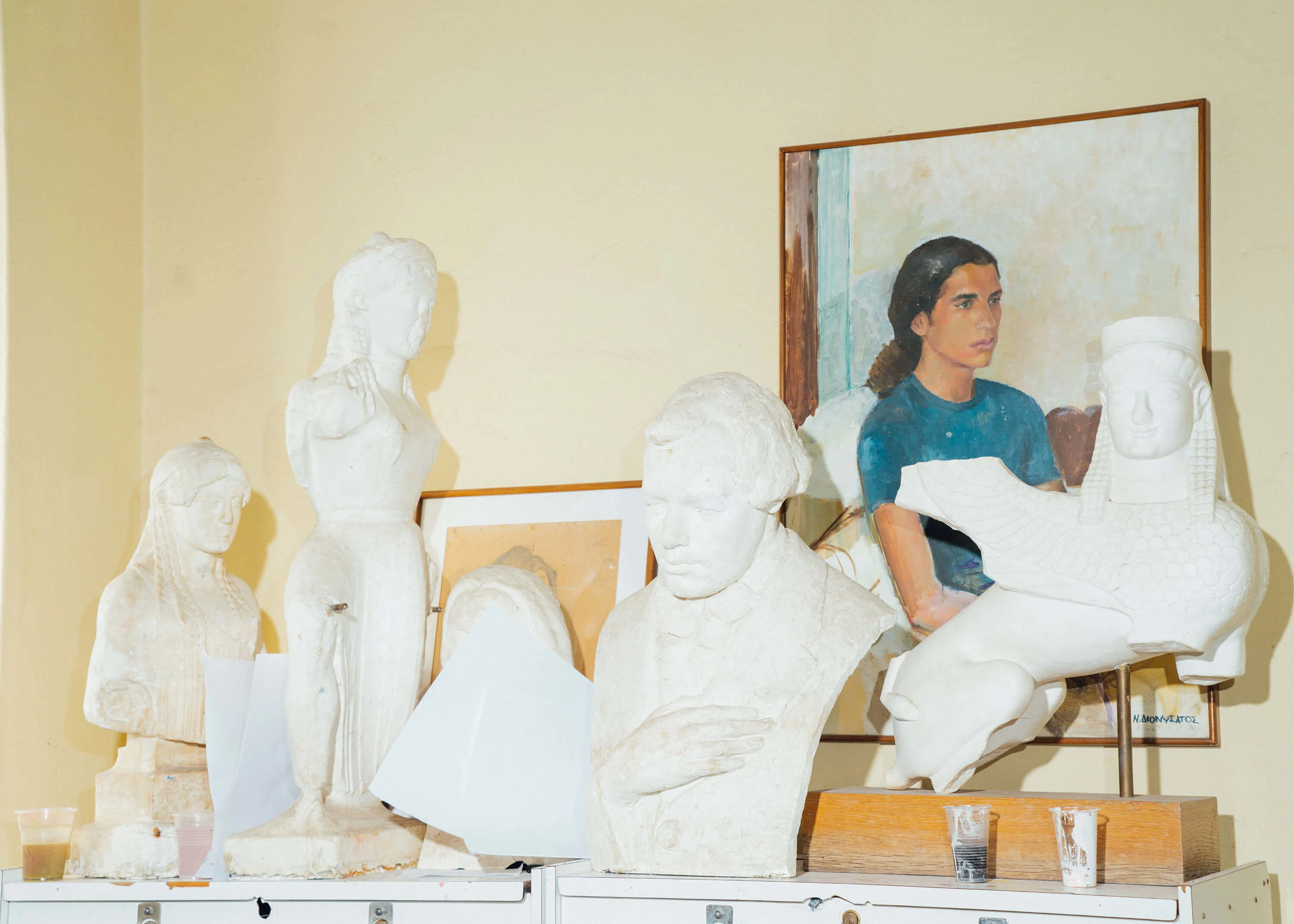
Tinos is the birthplace of some of Greece’s most famous modern sculptors, including Yannoulis Chalepas, Dimitros Filippotis, the Sochos brothers, and the Fytalis brothers. Marble sculpting is so interwoven into the history, society, economy, and cultural identity of Tinos that it was granted UNESCO Intangible Heritage status in 2016. You can find Tinian marble in the Parthenon, the Louvre and in Buckingham Palace; Tinian sculptors helped to rebuild many of Greece’s most important archaeological sites.
I arrived in Tinos on a cloudy November afternoon that turned into a storm-drenched evening – much in the same way, I like to think, how Phidias, the ancient sculptor of Zeus at Olympia (one of the Seven Wonders of the World) arrived 2,500 years ago. Like all good things Greek, marble sculpting in Tinos has its roots in mythology: Phidias landed in Tinos on his way to the holy religious site of Delos. While moored on the island due to bad weather, the prolific sculptor taught his craft to the locals – and thus a new way of life was born.

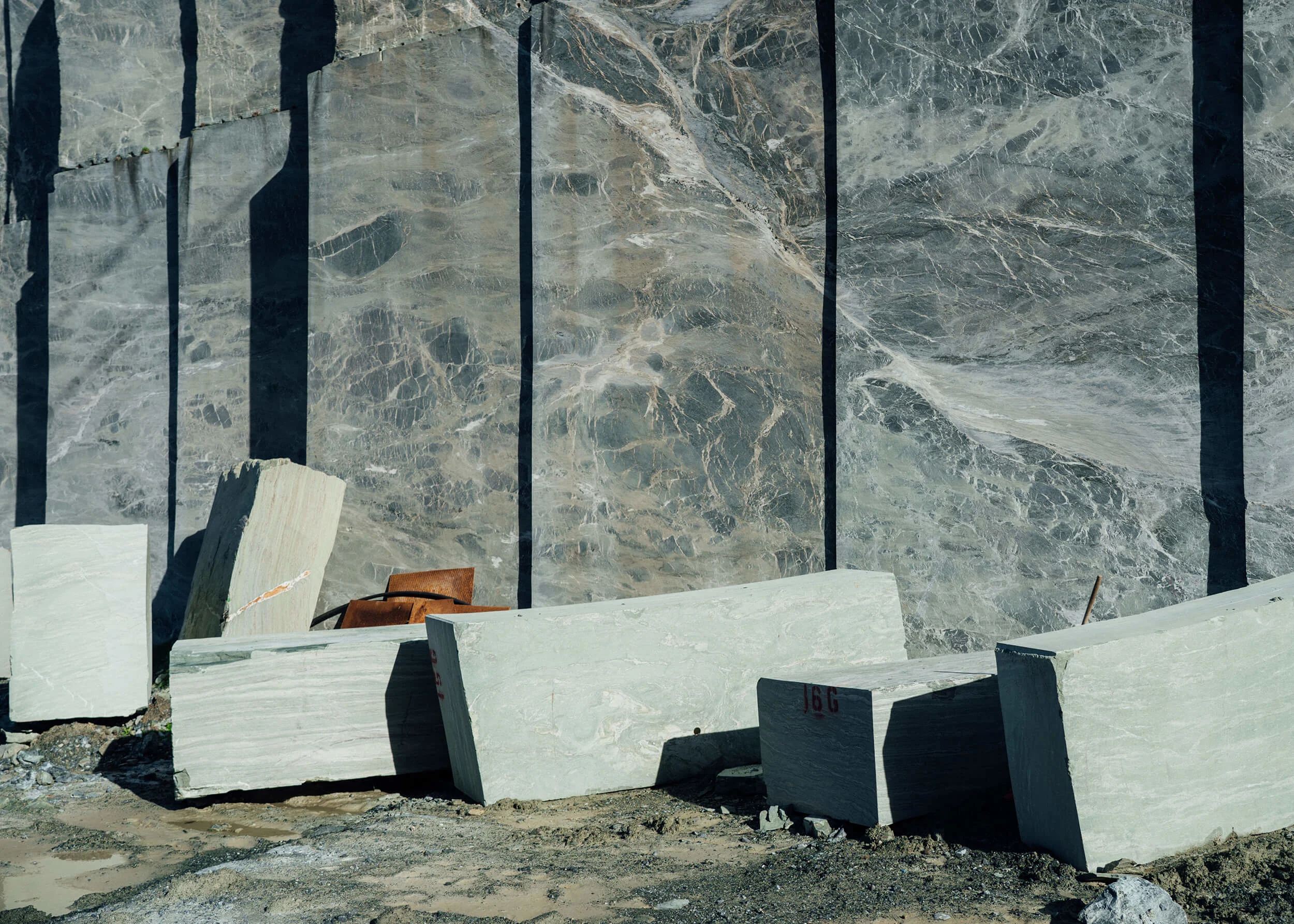
It helps that the geographical morphology of Tinos is such that marble seems to physically sprout out of the ground, particularly where it is most concentrated in the northwestern part of the island. Marble quarries – of which there are now only two still left operating on the island – employed many men in Pyrgos, and supplied marble to construction sites across Greece. There are eight types of marble originating from there; the most famous having a swirled green pattern that looks like futuristic melted ice cream.
Only a few decades ago, the village had a population of 2,500, around 500 of which were involved in the production of marble, as quarry workers, craftsmen, or sculptors. It seemed everyone was somehow related to a marble worker. Today, there are only around 10 professional sculptors left in the village, most of whom carve away in the winter (small boats, rounded hearts, Cycladic miniatures) and sell their wares to tourists in the summer months. The village is so small that all the sculptors know each other, and have personal preferences for one’s work or style, though rivalries are generally non-existent. I arrived on Tinos with only Marmarinos’ number in my phone; within a few hours I had met everyone else.



In the cemetery, the tombs of deceased sculptors are marked by a carved hammer and chisel. In other villages or cities, people mark their territory using cans of spray paint; in Pyrgos, it’s a rite of passage to carve into the streets and stairs themselves. Walk around the island and you’ll find a most artistic form of graffiti: facial profiles, a stick house and sun, initials, all carved into rock.
“The village is a class itself,” says Leonidas Chalepas, director of sculpture at the Tinos School of Fine Arts, which opened in 1955 and currently has 35 students enrolled. “There’s an osmosis with the society.” The school has been instrumental in cementing Tinos’ role in contemporary marble sculpting, and attracts students from all over the country. Nearly all of the sculptors in Tinos, including Marmarinos, studied here. Students are taught the process of sculpting in clay, plaster, and stone, just a short walk from the center of Pyrgos.





Adonis Vidos, now 93-years-old, remains an active participant in Tinos’ marble community. His eyes are still sharp and lively; upon arriving at his house, his stooped wife kindly brings out Turkish coffee and spoon sweets while Vidos plays a rousing tune on his guitar. He is a living example of marble history: sent to the marble quarries at age 12, he worked there until World War II came knocking on the doorstep. He was trained as a soldier by the British in Palestine, before being stationed in Rimini. “Whoever survived came back,” he said with a nonchalant shrug.
As one of these survivors, Adonis returned and went back to work in the quarry, until he realized he could make more money working on ships. Returning to his craft once more, he continued his marble sculpting. The shed in his garden is crowded with creamy white statutes. “I feel like I’m leaving something behind for the younger generation,” he said holding a white marble dove, though he adds with a trace of bitterness, “the younger generation doesn’t care about this so much.” Here lay two reasons for the decline of sculpting in Greece – it’s no longer an economically viable way to live, and it’s hard work.

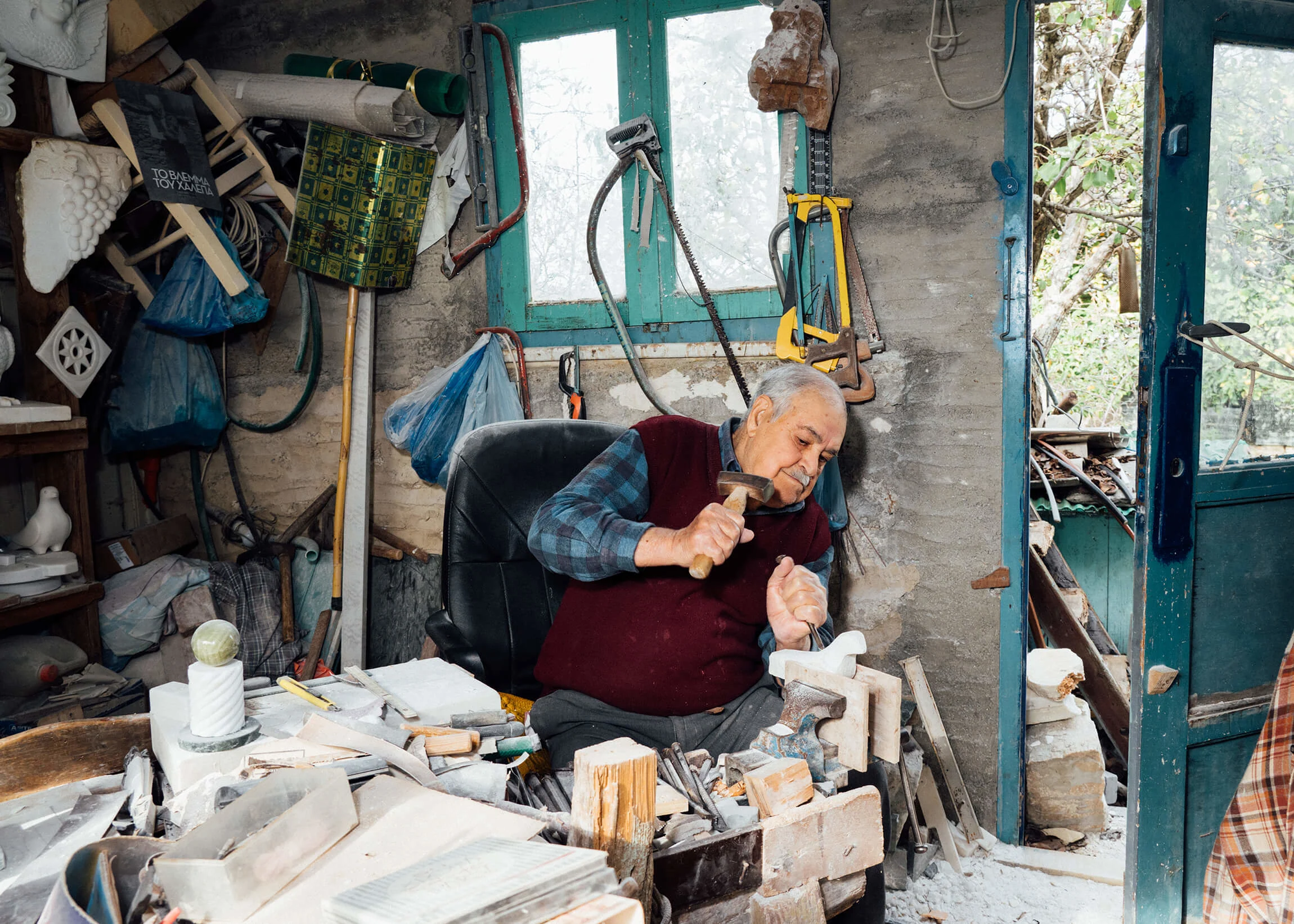
“Life is never easy for artists, even in good times,” says Chalepas. He says sculpture is “a way of life,” which is true in that it’s so much more physically engaging than other art forms. Artists’ bodies become impacted by sculpting: biceps bulge, backs bend, dust gets caught in the eyes and lungs. Cigarettes seem to be the perfect accompaniment to sculpting; most sculptors I met spent their formative years in a cloud of blue smoke. And time is an integral part of the process – creating just a small marble cup takes a full day’s work. Larger sculptures can take several months, years even. “Marble sculpting isn’t a philosophy,” says sculptor Yannis Kasirogis with a laugh. “It’s work. If only you could see my lungs! But still, it’s my life.” I met Yannis on his birthday, and his wife brought out a chocolate cake and cups of herbal tea for us. He turned 71 the day we met, and has been sculpting since he was a kid.
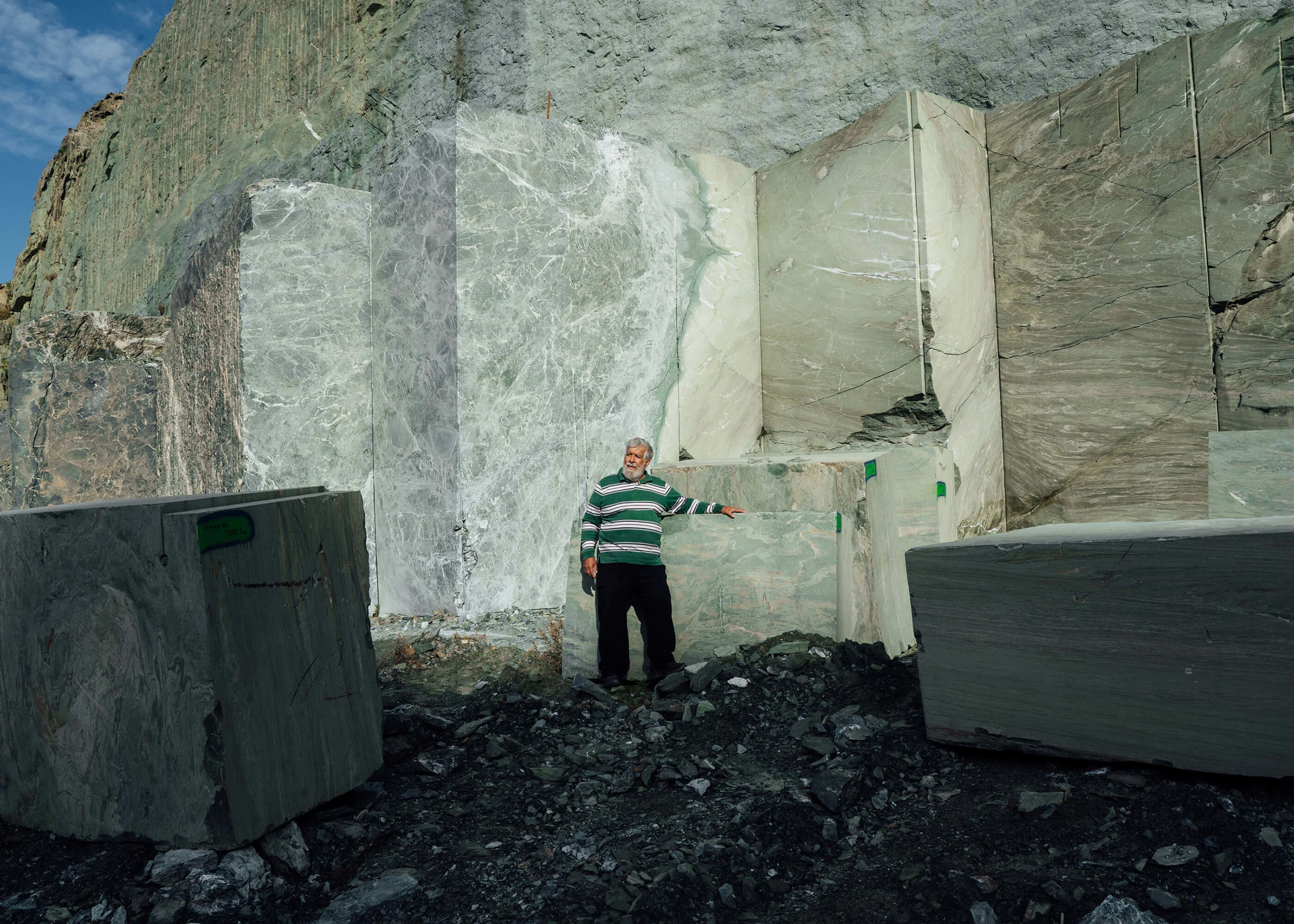
“There’s a real obsession here,” says Marmarinos. “Sometimes I don’t even know what I’m doing . I’m convinced it’s something genetic in me. Sometimes you are just born correctly in a place, to do what you are supposed to do.” Like many Tinians, Marmarinos’ grandfather was a sculptor, and most of the men in his family worked in the quarries.
“The emotion is the most important thing in sculpture,” he continues. “If I’m not well, I can’t sculpt.” The space and the tools come in second place. That said, it’s impossible to carve without at least the most basic tools and each sculptor has his or her own hammer and chisel. Marmarinos picks up a several-decades old hammer, the wood perfectly dented to fit his large hand after years of use.


If sculpture is carved in the light, then the tools to make it – hammer, chisel – are forged in the dark. Perched on the winding road leading out of Pyrgos is the small, soot-covered studio of Dimitris Chathis, the last blacksmith in Tinos. For the past 28 years he’s been making tools for the island’s marble sculptors, chiseling his own signature into the tools. When he first started out, he approximates that 80% of the tools he made were for sculptors. Now it’s more like 30%.
“We’ve been making these tools the same way for thousands of years. If you go to Acropolis, you will see that they used the same tools that I make,” says Chathis. How poetically beautiful to dedicate one’s life to hacking away at squares to make another shape (“Don’t think of it as taking away space,” Chalepas told me, “think of it as adding space”) using the same tools and techniques as one’s ancestors. The methods, the sounds, and the smells are largely the same as they were back in ancient times.


I leave the dust and grime of the workshop and walk on to the road, which affords a stunning panorama of rolling green hills, the sea shimmering in the distance, the sugar cube white houses of Pyrgos in the valley. The wind whips up the salt of the sea; I can taste it on my tongue. There is a slowness here, reflected in the environment and the craftsmanship that I find sorely lacking in most of our lives, so consumed they are by the instant gratification and speed of capitalism. Unlike so many other forms of physical labor, which has replaced bodies with robots and cranes, there is a humanness that is threaded through marble sculpting. History can seem so scrubbed and sanitized; here, it is laid bare with the spectrum of its qualities on display. The beautiful finished product contrasted with the economic hardship, the artistic perseverance, the sweaty un-Instagrammable characteristic of it all.


